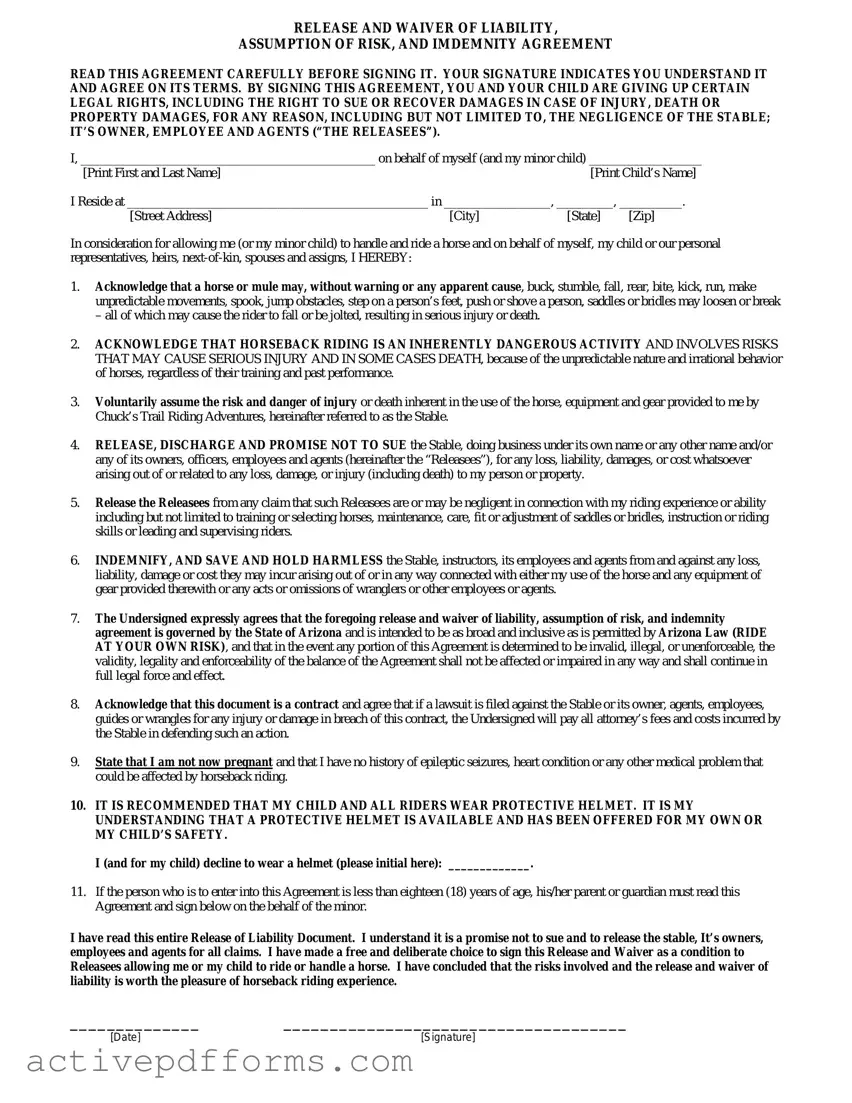RELEASE AND WAIVER OF LIABILITY,
ASSUMPTION OF RISK, AND IMDEMNITY AGREEMENT
READ THIS AGREEMENT CAREFULLY BEFORE SIGNING IT. YOUR SIGNATURE INDICATES YOU UNDERSTAND IT AND AGREE ON ITS TERMS. BY SIGNING THIS AGREEMENT, YOU AND YOUR CHILD ARE GIVING UP CERTAIN LEGAL RIGHTS, INCLUDING THE RIGHT TO SUE OR RECOVER DAMAGES IN CASE OF INJURY, DEATH OR PROPERTY DAMAGES, FOR ANY REASON, INCLUDING BUT NOT LIMITED TO, THE NEGLIGENCE OF THE STABLE; IT’S OWNER, EMPLOYEE AND AGENTS (“THE RELEASEES”).
I, _______________________________________________ on behalf of myself (and my minor child) __________________
[Print First and Last Name][Print Child’s Name]
I Reside at ________________________________________________ in _________________, _________, __________.
[Street Address] |
[City] |
[State] |
[Zip] |
In consideration for allowing me (or my minor child) to handle and ride a horse and on behalf of myself, my child or our personal representatives, heirs, next-of-kin, spouses and assigns, I HEREBY:
1.Acknowledge that a horse or mule may, without warning or any apparent cause, buck, stumble, fall, rear, bite, kick, run, make unpredictable movements, spook, jump obstacles, step on a person’s feet, push or shove a person, saddles or bridles may loosen or break
– all of which may cause the rider to fall or be jolted, resulting in serious injury or death.
2.ACKNOWLEDGE THAT HORSEBACK RIDING IS AN INHERENTLY DANGEROUS ACTIVITY AND INVOLVES RISKS THAT MAY CAUSE SERIOUS INJURY AND IN SOME CASES DEATH, because of the unpredictable nature and irrational behavior of horses, regardless of their training and past performance.
3.Voluntarily assume the risk and danger of injury or death inherent in the use of the horse, equipment and gear provided to me by Chuck’s Trail Riding Adventures, hereinafter referred to as the Stable.
4.RELEASE, DISCHARGE AND PROMISE NOT TO SUE the Stable, doing business under its own name or any other name and/or any of its owners, officers, employees and agents (hereinafter the “Releasees”), for any loss, liability, damages, or cost whatsoever arising out of or related to any loss, damage, or injury (including death) to my person or property.
5.Release the Releasees from any claim that such Releasees are or may be negligent in connection with my riding experience or ability including but not limited to training or selecting horses, maintenance, care, fit or adjustment of saddles or bridles, instruction or riding skills or leading and supervising riders.
6.INDEMNIFY, AND SAVE AND HOLD HARMLESS the Stable, instructors, its employees and agents from and against any loss, liability, damage or cost they may incur arising out of or in any way connected with either my use of the horse and any equipment of gear provided therewith or any acts or omissions of wranglers or other employees or agents.
7.The Undersigned expressly agrees that the foregoing release and waiver of liability, assumption of risk, and indemnity agreement is governed by the State of Arizona and is intended to be as broad and inclusive as is permitted by Arizona Law (RIDE AT YOUR OWN RISK), and that in the event any portion of this Agreement is determined to be invalid, illegal, or unenforceable, the validity, legality and enforceability of the balance of the Agreement shall not be affected or impaired in any way and shall continue in full legal force and effect.
8.Acknowledge that this document is a contract and agree that if a lawsuit is filed against the Stable or its owner, agents, employees, guides or wrangles for any injury or damage in breach of this contract, the Undersigned will pay all attorney’s fees and costs incurred by the Stable in defending such an action.
9.State that I am not now pregnant and that I have no history of epileptic seizures, heart condition or any other medical problem that could be affected by horseback riding.
10.IT IS RECOMMENDED THAT MY CHILD AND ALL RIDERS WEAR PROTECTIVE HELMET. IT IS MY UNDERSTANDING THAT A PROTECTIVE HELMET IS AVAILABLE AND HAS BEEN OFFERED FOR MY OWN OR MY CHILD’S SAFETY.
I (and for my child) decline to wear a helmet (please initial here): _____________.
11.If the person who is to enter into this Agreement is less than eighteen (18) years of age, his/her parent or guardian must read this Agreement and sign below on the behalf of the minor.
I have read this entire Release of Liability Document. I understand it is a promise not to sue and to release the stable, It’s owners, employees and agents for all claims. I have made a free and deliberate choice to sign this Release and Waiver as a condition to Releasees allowing me or my child to ride or handle a horse. I have concluded that the risks involved and the release and waiver of liability is worth the pleasure of horseback riding experience.
______________ _____________________________________
